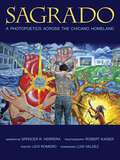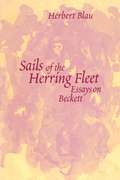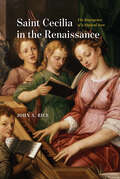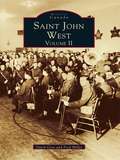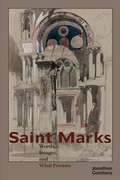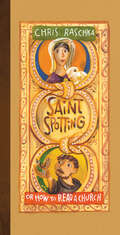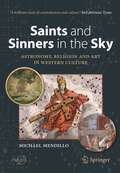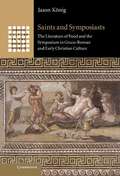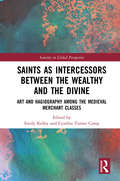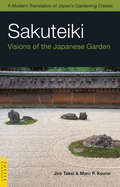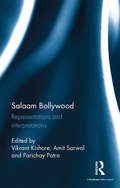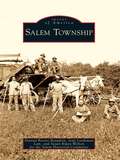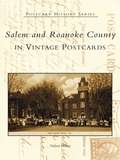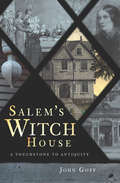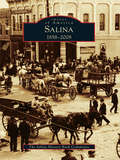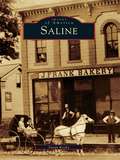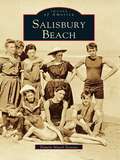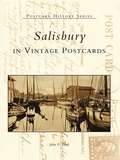- Table View
- List View
Sagrado: A Photopoetics Across the Chicano Homeland (Querencias Series)
by Spencer R. Herrera Romero LeviUn lugar sagrado, a sacred place where two or more are gathered in the name of community, can be found almost anywhere and yet it is elusive: a charro arena behind a rock quarry, on the pilgrimage trail to Chimayó, a curandero&’s shrine in South Texas, or at a binational Mass along the border. Sagrado is neither a search for identity nor a quest for a homeland but an affirmation of an ever-evolving cultural landscape. Embedded at the heart of this remarkable book, in which prose, photographs, and poems complement each other, is a photopoetic journey across the Chicano Southwest.
Sails of the Herring Fleet
by Herbert BlauSails of the Herring Fleet traces esteemed director and theorist Herbert Blau's encounters with the work of Samuel Beckett. Blau directed Beckett's plays when they were still virtually unknown, and for more than four decades has remained one of the leading interpreters of his work. In addition to now-classic essays, the collection includes early program notes and two remarkable interviews -- one from Blau's experience directing Waiting for Godot at San Quentin prison, and one from his last visit with Beckett, just before the playwright's death. Herbert Blau is Byron W. and Alice L. Lockwood Professor of the Humanities, University of Washington.
Saint Cecilia in the Renaissance: The Emergence of a Musical Icon
by John A. RiceThis study uncovers how Saint Cecilia came to be closely associated with music and musicians. Until the fifteenth century, Saint Cecilia was not connected with music. She was perceived as one of many virgin martyrs, with no obvious musical skills or interests. During the next two centuries, however, she inspired many musical works written in her honor and a vast number of paintings that depicted her singing or playing an instrument. In this book, John A. Rice argues that Cecilia’s association with music came about in several stages, involving Christian liturgy, visual arts, and music. It was fostered by interactions between artists, musicians, and their patrons and the transfer of visual and musical traditions from northern Europe to Italy. Saint Cecilia in the Renaissance explores the cult of the saint in Medieval times and through the sixteenth century when musicians’ guilds in the Low Countries and France first chose Cecilia as their patron. The book then turns to music and the explosion of polyphonic vocal works written in Cecilia’s honor by some of the most celebrated composers in Europe. Finally, the book examines the wealth of visual representations of Cecilia especially during the Italian Renaissance, among which Raphael’s 1515 painting, The Ecstasy of Saint Cecilia, is but the most famous example. Thoroughly researched and beautifully illustrated in color, Saint Cecilia in the Renaissance is the definitive portrait of Saint Cecilia as a figure of musical and artistic inspiration.
Saint George Between Empires: Image and Encounter in the Medieval East
by Heather A. BadamoThis volume examines Saint George’s intertwined traditions in the competing states of the eastern Mediterranean and Transcaucasia, demonstrating how rival conceptions of this well-known saint became central to Crusader, Eastern Christian, and Islamic medieval visual cultures.Saint George Between Empires links the visual cultures of Byzantium, North Africa, the Levant, Syria, and the Caucasus during the Crusader era to redraw our picture of interfaith relations and artistic networks. Heather Badamo recovers and recontextualizes a vast body of images and literature—from etiquette manuals and romances to miracle accounts and chronicles—to describe the history of Saint George during a period of religious and political fragmentation, between his “rise” to cross-cultural prominence in the eleventh century and his “globalization” in the fifteenth. In Badamo’s analysis, George emerges as an exemplar of cross-cultural encounter and global translation.Featuring important new research on monuments and artworks that are no longer available to scholars as a result of the occupation of Syria and parts of Iraq, Saint George Between Empires will be welcomed by scholars of Byzantine, medieval, Islamic, and Eastern Christian art and cultural studies.
Saint Joan: Her History And The Play (Clydesdale Classics)
by George Bernard ShawRediscover the story of the inspirational Saint Joan of Arc with the classic play by George Bernard Shaw. The historical saint begins her story as a simple country girl in fifteenth century France who is inspired by visions from God to help liberate her country from the English. She secures soldier&’s clothing and convinces the soon-to-be king, Charles, to begin battling for his country. Though her regiment succeeds in battle after battle, her enemies (the English) move against her. When Joan moves to liberate Paris from the English control—against the advice of her friends—she is captured and tried for heresy. Despite help from a Bishop and the Inquisitor, who truly want to see Joan succeed, her beliefs simply do not match with the Church; people do not hear visions from God, only from the church, therefore Joan must be possessed by demons. Subsequently, Joan is sentenced to death. Now read this beautiful new edition of the talented George Bernard Shaw&’s play, Saint Joan. Discover why the Catholic Church made this young woman into one of the most famous saints known today.
Saint John West: Volume II (Historic Canada)
by David Goss Fred MillerSaint John West Volume II adds to and continues the story of the West Side's struggle for existence. Always dependent on seasonal industry, initially fishing and shipbuilding and later the railway and seaport, the area has seen high and low points in its 200-plus years of existence. At one time, residents imagined times would become so prosperous that King Street would be transformed into a major boulevard paved with gold and Courtenay Hill would be the site of a huge, decorative cathedral dedicated to the inner spirit. In reality, the fish have stopped coming, the wooden ships are no longer built, and the Canadian Pacific railway that provided hundreds of jobs and promised such hope has left the Maritimes. Changing trade patterns and political favours to keep the St. Lawrence open to Montreal has devastated the winter-port operations. Many Saint John West residents have had to close their businesses and move on. Others were displaced when the construction of the Harbour Bridge tore three full blocks out of the heart of the community in 1968. Still others have chosen to remain, and today, though little industry exists, the area is still vibrant and working hard to hold together some vestige of the pride of former times.
Saint John's Abbey Church: Marcel Breuer and the Creation of a Modern Sacred Space
by Victoria M. YoungIn the 1950s the brethren at the Benedictine Abbey of Saint John the Baptist in Collegeville, Minnesota—the largest Benedictine abbey in the world—decided to expand their campus, including building a new church. From a who&’s who of architectural stars—such as Walter Gropius, Richard Neutra, Pietro Belluschi, Barry Byrne, and Eero Saarinen—the Benedictines chose a former member of the Bauhaus, Marcel Breuer. In collaboration with the monks, this untested religious designer produced a work of modern sculptural concrete architecture that reenvisioned what a church could be and set a worldwide standard for midcentury religious design. Saint John&’s Abbey Church documents the dialogue of the design process, as Breuer instructed the monks about architecture and they in turn guided him and his associates in the construction of a sacred space in the crucial years of liturgical reform. A reading of letters, drawings, and other archival materials shows how these conversations gave shape to design elements from the church&’s floor plan to the liturgical furnishings, art, and incomparable stained glass installed within it. The book offers a rare detailed view of how a patron and architect work together in a successful building campaign—one that, in this case, lasted for two decades and resulted in designs for twelve buildings, ten of which were completed.The post–World War II years were critical in the development of religious and architectural experiences in the United States—experiences that came together in the construction of Saint John&’s Abbey and University Church and that find their full expression in Victoria M. Young&’s account of the process. Using the liturgy of the mid-twentieth century as a cornerstone for understanding the architecture produced to support it, her book showcases the importance of modernism in the design of sacred space, and of Marcel Breuer&’s role in setting the standard.
Saint Marks: Words, Images, and What Persists
by Jonathan GoldbergSaint Marks invokes and pluralizes the figure of Mark in order to explore relations between painting and writing. Emphasizing that the saint is not a singular biographical individual in the various biblical and hagiographic texts that involve someone so named, the book takes as its ultimate concern the kinds of material life that outlive the human subject.From the incommensurate, anachronic instances in which Saint Mark can be located—among them, as Evangelist or as patron saint of Venice—the book traces Mark’s afterlives within art, sacred texts, and literature in conversation with such art historians and philosophers as Aby Warburg, Giorgio Agamben, Georges Didi-Huberman, T. J. Clark, Adrian Stokes, and Jean-Luc Nancy. Goldberg begins in sixteenth-century Venice, with a series of paintings by Gentile and Giovanni Bellini, Tintoretto, and others, that have virtually nothing to do with biblical texts. He turns then to the legacy of John Ruskin’s Stones of Venice and through it to questions about what painting does as painting. A final chapter turns to ancient texts, considering the Gospel of St. Mark together with its double, the so-called Secret Gospel that has occasioned controversy for its homoerotic implications.The posthumous persistence of a life is what the gospel named Mark calls the Kingdom of God. Saints have posthumous lives; but so too do paintings and texts. This major interdisciplinary study by one of our most astute cultural critics extends what might have been a purely theological subject to embrace questions central to cultural practice from the ancient world to the present.
Saint Peter's College
by Joseph Mclaughlin Thomas MatteoSaint Peter's College was founded in 1872 by the Jesuits as a Catholic liberal arts college for men. Situated in an urban setting, the college seeks to develop the whole person in preparation for a lifetime of learning, leadership, and service in a diverse and global society. In 1966, Saint Peter's became coeducational and today educates students from 65 countries all over the world. Committed to academic excellence and individual attention, Saint Peter's College provides education, informed by values, primarily in degree-granting programs in the arts, sciences, and business to resident and commuting students from a variety of backgrounds.
Saint Spotting: Or How To Read A Church
by Chris RaschkaA church is a weighty thing, isn&’t it? Its doors are heavy and hard to budge. Its walls are made of stone. And there may be strange or even scary pictures inside. How can a small person make sense of these intimidating places? Two-time Caldecott medalist Chris Raschka shares his mother&’s wonderful way of visiting a church: what they would call saint spotting. Each visit to a church becomes an adventure, a trip through the stories that have shaped centuries of faith.Playful and poignant, this beautifully illustrated book introduces readers to saints and symbols through the warm bond between a mother and son. From bookish Paul to faithful Mary Magdalene, from musical Cecilia to animal-loving Francis, there&’s a fascinating saint to discover in every corner.
Saints and Sinners in the Sky: Astronomy, Religion and Art in Western Culture (Springer Praxis Books)
by Michael Mendillo"A brilliant study of constellations and culture." - Neil deGrasse TysonIn this book, Boston University Professor of Astronomy Michael Mendillo takes readers deep into the annals of history, showing how visual depictions of the heavens evolved in tandem with science and religion throughout much of Western culture. With unprecedented scope and scale, Professor Mendillo explores how cave art, illuminated manuscripts, sculptures, paintings and architecture reflected some of the great religious and secular battles taking place over the course of centuries. Enter a world of biblical proportions, where constellations of ancient heroes and pagans were thoroughly recast as Christian saints and the Twelve Apostles. This nontechnical narrative brings vitality and accessibility to some of the most enduring subjects in human history, offering a lively new exploration of the visual connections between celestial phenomena and artistic expression."Saints and Sinners impressionistically reveals the connections of art, astronomy, and religion in Western culture to illuminate the age-old quest for celestial-terrestrial connections.” - Roberta J.M. Olson, author of Giotto’s Portrait of Halley’s Comet and Cosmos: The Art and Science of the Universe “Professor Mendillo’s book does a priceless service, opening the doors of our minds to images that will stir us, because the heavens are part of us, and we all long to know how and why.” - Rev. David R. Thom, MIT Chaplain and Convener of the Cambridge Faculty Roundtable on Science, Art & Religion "Over a lifetime devoted to astronomical research and teaching, Michael Mendillo has indulged a parallel passion for artistic representations of the heavenly bodies. In this sumptuous volume, he explores the projection of our changing belief systems onto the constant stars.” - Dava Sobel, author of Longitude, Galileo’s Daughter and The Glass Universe
Saints and Symposiasts
by Jason KönigGreek traditions of writing about food and the symposium had a long and rich afterlife in the first to fifth centuries CE, in both Greco-Roman and early Christian culture. This book provides an account of the history of the table-talk tradition, derived from Plato's Symposium and other classical texts, focusing among other writers on Plutarch, Athenaeus, Methodius and Macrobius. It also deals with the representation of transgressive, degraded, eccentric types of eating and drinking in Greco-Roman and early Christian prose narrative texts, focusing especially on the Letters of Alciphron, the Greek and Roman novels, especially Apuleius, the Apocryphal Acts of the Apostles and the early saints' lives. It argues that writing about consumption and conversation continued to matter: these works communicated distinctive ideas about how to talk and how to think, distinctive models of the relationship between past and present, distinctive and often destabilising visions of identity and holiness.
Saints as Intercessors between the Wealthy and the Divine: Art and Hagiography among the Medieval Merchant Classes (Sanctity in Global Perspective)
by Emily Kelley Cynthia Turner CampOffering snapshots of mercantile devotion to saints in different regions, this volume is the first to ask explicitly how merchants invoked saints, and why. Despite medieval and modern stereotypes of merchants as godless and avaricious, medieval traders were highly devout – and rightly so. Overseas trade was dangerous, and merchants’ commercial activities were seen as jeopardizing their souls. Merchants turned to saints for protection and succor, identifying those most likely to preserve their goods, families, reputations, and souls. The essays in this collection, written from diverse angles, range across later medieval western Europe, from Spain to Italy to England and the Hanseatic League. They offer a multi-disciplinary examination of the ways that medieval merchants, from petty traders to influential overseas wholesalers, deployed the cults of saints. Three primary themes are addressed: danger, community, and the unity of spiritual and cultural capital. Each of these themes allows the international panel of contributors to demonstrate the significant role of saints in mercantile life. This book is unique in its exploration of saints and commerce, shedding light on the everyday role religion played in medieval life. As such, it will be of keen interest to scholars of religious history, medieval history, art history, and literature.
Sakuteiki
by Marc P. Keane Jiro TakeiThe Sakuteiki, or "Records of Garden Making," was written nearly one thousand years ago. It is the oldest existing text on Japanese gardening-or any kind of gardening—in the world. In this edition of the Sakuteiki the authors provide both an English-language translation of this classic work and an introduction to the cultural and historical context that led to the development of Japanese gardening.
Salaam Bollywood: Representations and interpretations
by Vikrant Kishore Amit Sarwal Parichay PatraThis book traces the journey of popular Hindi cinema from 1913 to contemporary times when Bollywood has evolved as a part of India’s cultural diplomacy. Avoiding a linear, developmental narrative, the book re-examines the developments through the ruptures in the course of cinematic history. The essays in the volume critically consider transformations of the Hindi film industry from its early days to its present self-referential mode, issues of gender, dance and choreography, Bombay cinema’s negotiations with the changing cityscape and urbanisms, and concentrate on its multifarious regional, national and transnational implications in the 21st century. One of the most comprehensive volumes on Bollywood, this work presents an analytical overview of the multiple histories of popular cinema in India and will be useful to scholars and researchers interested in film and media studies, South Asian popular culture and modern India, as well as to cinephiles and general readers alike.
Salem Township
by Jean Loedeman Lam Salem Historical Committee Dianna Beaudoin Susan Kipen WeltonBefore white settlers came to the area that is now Salem Township, Potawatomi Indians hunted and fished in a forest filled with abundant wildlife. The settlers cleared the trees to work the land and built a lumber mill along Little Rabbit River. Salem was primarily a farming community carved out by hardworking pioneers. Four towns were established to serve this farming community: Diamond Springs to the south, New Salem to the north, and Burnips Corners and Salem Center (now known as Burnips) in the center. In 1855, Salem Township separated from Monterey Township; then, in the 1930s, the discovery of oil brought financial relief to Salem farm families who struggled to maintain their farms. A new wave of residents came to settle in the Salem area as men seeking work in the oil fields brought their families to the community.
Salem and Roanoke County in Vintage Postcards
by Nelson HarrisIn 1800, James Simpson, a Botetourt County landowner, purchased 31 acres of land for $100 and dedicated half of the purchase to plotting a new town. The Town of Salem was officially established when Simpson recorded his ownership at Fincastle Courthouse in October 1802, and it later became the government seat when Roanoke County was carved from Botetourt County in 1838. Today, Salem is an independent city, boasting a rich tradition of educational, commercial, and residential success. Roanoke County, like Salem, has emerged from its agrarian past to become a suburban county that embraces the beauty of the Blue Ridge Mountains, as well as the strength and success of corporate centers and residential communities.
Salem's Witch House: A Touchstone to Antiquity (Landmarks Ser.)
by John GoffA close-up look at this historic Massachusetts landmark, including photos and illustrations. Though Salem is located on Massachusetts&’s scenic North Shore, its history has not always been picturesque. The &“Witch City,&” as it is internationally known, is home to numerous landmarks dedicated to the notorious trials of 1692. Of these, the Witch House is perhaps most significant—the former residence of Judge Jonathan Corwin, whose court ordered the execution of twenty men and women. It was here that Corwin examined the unfortunate accused. There is, however, more to this ancient building than its most famous occupant. From wars and death to prosperity and progress, this book searches beneath the beams and studs of the Witch House—to find the stories of those who called this place home.
Salem: Victorian Salem In 3d: A Collection Of 70 Images Of Victorian Salem From The 1870s With A 3d Viewer (Then and Now)
by Jerome M. Curley Nelson L. DionneSalem, Massachusetts, is a little city steeped in history. Known as the Witch City for the Puritan witchcraft trials of 1692, Salem boasts a rich heritage as a major East India seaport. Trading with China made Salem the richest city in America, generating a living architectural history. As Salem developed, it preserved much of its history.Known as the Witch City for the Puritan witchcraft trials of 1692, Salem boasts a rich heritage as a major East India seaport. Trading with China made Salem the richest city in America, generating a living architectural history. As Salem developed, it preserved much of its history.
Salesforce Lightning Reporting and Dashboards
by Johan YuLearn how to build advanced reports and dashboards in Salesforce Lightning experience About This Book • Visualize and create advanced reports and dashboards using Lightning Experience • Improve overall business efficiency with advanced and effective reports and dashboards • Understand and create custom reports and dashboards Who This Book Is For This book is targeted at Salesforce.com administrators, business analysts, and managers who use Salesforce.com for their daily job and want to learn in depth about Salesforce Reporting and Dashboard in Lightning Experience. Readers should have a basic knowledge of Salesforce, such as: Accounts, Contacts, Leads, Opportunities and custom objects. What You Will Learn • Navigate in Salesforce.com within the Lightning Experience user interface • Secure and share your reports and dashboards with other users • Create, manage, and maintain reports using Report Builder • Learn how the report type can affect the report generated • Explore the report and dashboard folder and the sharing model • Create reports with multiple formats and custom report types • Explore various dashboard features in Lightning Experience • Use Salesforce1, including accessing reports and dashboards In Detail Built on the Salesforce App Cloud, the new Lightning Experience combines the new Lightning Design System, Lightning App Builder, and Lightning Components to enable anyone to quickly and easily create modern enterprise apps. The book will start with a gentle introduction to the basics of Salesforce reports and dashboards. It will also explain how to access reports in depth. Then you will learn how to create and manage reports, to use Schedule Report, and create advanced report configurations. The next section talks about dashboards and will enable you to understand and compare various types of dashboard component and how you can benefit the most from each of them. Then we move on to advanced topics and explain tips and tricks related to reports and dashboards, including reporting snapshots, report parameters, and collaboration. Finally, we will discuss how to access dashboards and reports from the Salesforce1 mobile app. Style and approach This comprehensive guide covers the advanced features of the all new Salesforce Lightning concepts and communicates them through a practical approach to explore the underlying concepts of how, when, and why to use them.
Salina: 1858-2008
by The Salina History Book CommitteeEarly in 1858, three men walked across the eastern half of Kansas Territory intent on starting a town. Although the volatile conflict between Free State and proslavery forces still simmered, the bloodshed had abated, and Free State factions had gained the upper hand. People turned their interests to more peaceful pursuits, including town building. Armed with a compass and stovepipe hat instead of a tripod, the three young Scotsmen selected and surveyed a town site along the Smoky Hill River, near the confluence of the Saline River in north-central Kansas. The tiny settlement soon became a way-stop for westbound travelers and a hub of activity for hunters, soldiers, land seekers, and surveyors. Now 150 years later, Salina (pronounced with a long i) still thrives as a center for commercial, cultural, civic, and social activity. Voted an All-America City in 1989, Salina is home to nearly 50,000 people who enjoy midwestern living in the heart of America.
Saline
by Susan KoskySince settlers first arrived in the early 1800s, the city of Saline has developed into a strong community with deep cultural roots. This informative book documents Saline's development and progress, exploring settlement, transportation, agriculture, architecture, business, and education through rare archival photographs. Author Susan Kosky takes readers on a detailed visual tour of Saline's rich history, revealing the remarkable people, places, and events that have shaped the area and made it what it is today.
Saline County (Images of America)
by Dustin Ray Shannon Faith DincoloEarly Saline County was a land rich in Native American history. Only a few settlers migrated to the area prior to the railroad development that started in 1867. Milling and grains, livestock, and even gypsum mining all influenced the growth of Saline County. Salina became a prominent city, whereas Hedville and other towns were altered, almost lost, as the railroads continued to build and change their depots, creating boom and bust economies in the county. Tornados, fires, droughts, and floods challenged the hardy souls who called this area home. Salina and the towns that have survived the booms and busts have a robust history.
Salisbury Beach (Images of America)
by Pamela Mutch StevensSalisbury Beach, surrounded by marshes and folklore of buried treasure, has long been a mecca for summer vacationers. In the "good ole summertime" of the 1890s, Salisbury Beach became the favorite resort of residents of the Merrimack Valley. Was it the magnetic force of the tide that beckoned people to the seaside, or was it the carefree carnival attitude that followed the Victorian era? Passengers arrived by horse, boat, train, electric trolley, andthen by automobile to picnic on the beach and partake of the healthy sea air. By the light of the moon and the roar of the surf, couples danced the sultry summer nights away in the Ocean Echo and later at the Frolics. With the recent demolition of the Frolics, those evenings of dancing cheek to cheek to the music of Lionel Hampton and Frank Sinatra reside now only in memories. But for a briefmoment in time, the gleaming white roller coaster towered like a giant skeleton over the amusement park while music piped out of the turret of the Ocean Echo Hotel, adding to the festive mood of the crowd.
Salisbury in Vintage Postcards (Postcard History)
by John E. JacobLocated in the center of the Delmarva Peninsula on the Wicomico River, Salisbury is a town steeped in history. Formed by an act of provincial legislature in 1732, Salisbury lies on the east bank of the river on the original land of William Winder. Salisbury developed into the commercial center of the peninsula by the time of the Civil War--it was the southernmost point at which all goods were shipped north. This strategic location also made Salisbury the distribution point for goods coming south, an advantage that placed the region at the center of the state's economic boom. In 1867, Wicomico County was formed and Salisbury was chosen as the county seat. In the 20th century, Salisbury prospered into a communication and financial center for all of lower Maryland.
